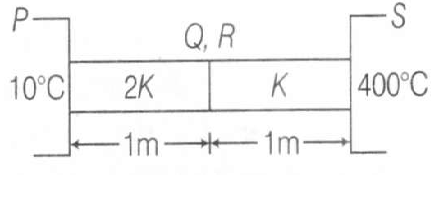Answer:
Option A
Explanation:

Rate of heat flow from P to Q,
$\frac{\text{d}Q}{\text{d}t}= \frac{2KA(T-10)}{1}$
Rate of heat flow from Q to S
$\frac{\text{d}Q}{\text{d}t}= \frac{KA(4000-T)}{1}$
At steady state, state rate of heat flow is same
$\therefore \frac{2KA(T-10)}{1}= KA(400-T)$
or 2T-20=400-T or 3T=420
T= 140°

The temperature of the junction is 140° C.
Temperature at a distance x from end P is Tx = (130 x+10°)
Change in lenght dx is suppose dy
Then, $dy=\propto dx(T_{x}-10)$
$\int_{0}^{\triangle y} dy= \int_{0}^{1} \propto dx(130x+10-10)$
$\triangle y=[\frac{\alpha x^{2}}{2}\times130]_0^1$
$\triangle y=1.2\times 10^{-5}\times 65$
$\triangle y= 78 \times 10^{-5}m=0.78 m$